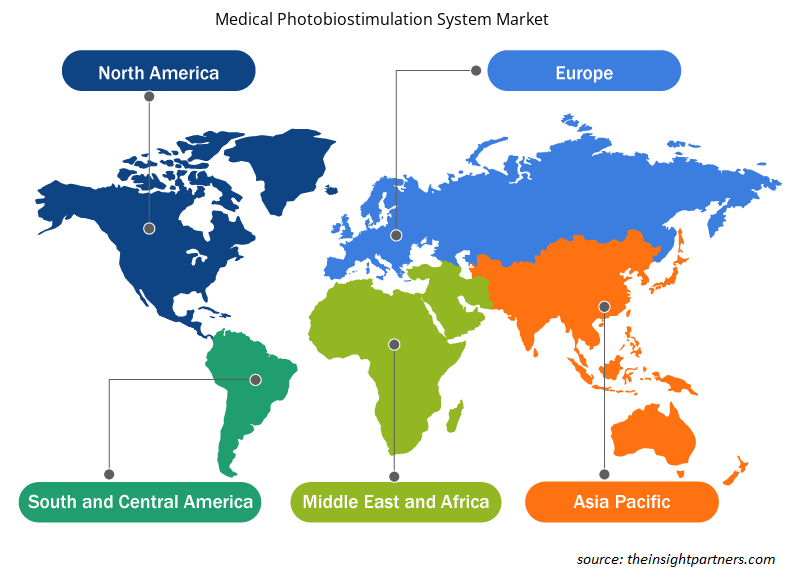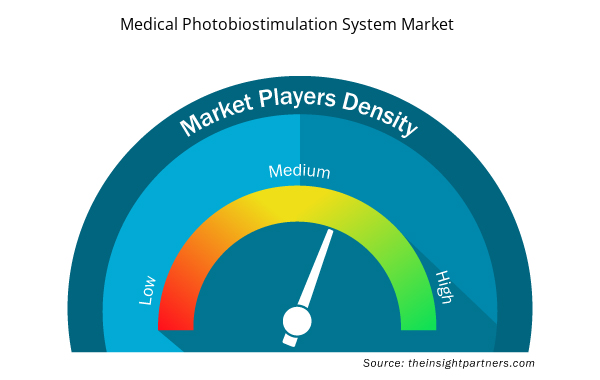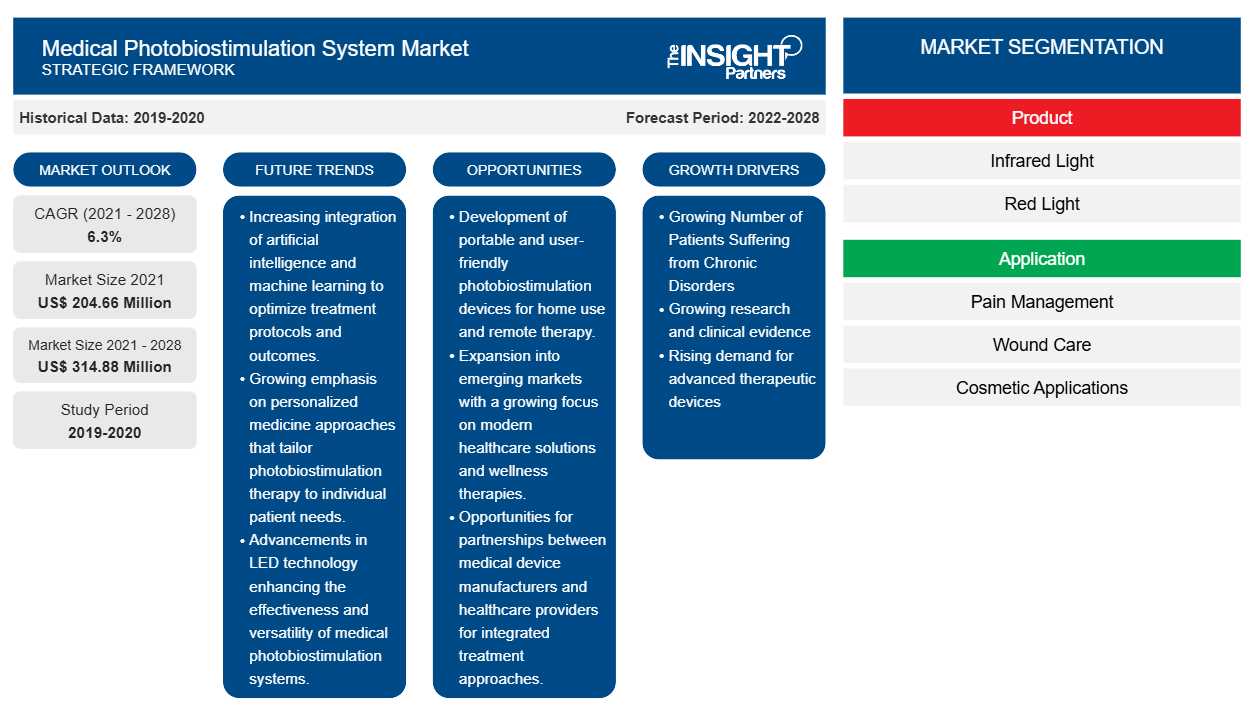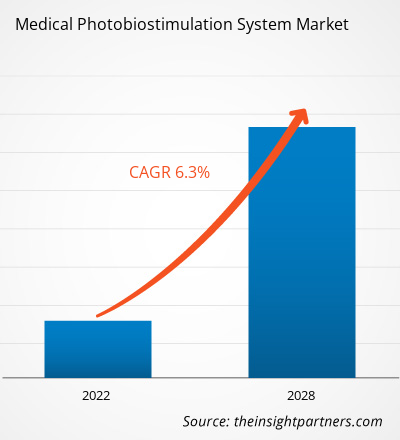Se proyecta que el mercado de sistemas de fotobioestimulación médica alcance los 314,88 millones de dólares en 2028, desde los 204,66 millones de dólares en 2021; se espera que crezca a una CAGR del 6,3% entre 2021 y 2028.
El creciente número de pacientes que padecen trastornos crónicos y dolor crónico y la creciente demanda de dispositivos de fotobioestimulación para el tratamiento del dolor y el cuidado de heridas debido al aumento de la población geriátrica son los principales factores que contribuyen al crecimiento del mercado. Sin embargo, el estricto marco regulatorio restringe el crecimiento del mercado. La terapia de fotobioestimulación médica también se conoce como terapia de luz de bajo nivel (LLLT) y se utiliza para reducir el dolor, la inflamación y promover la curación de heridas. Los dispositivos de fotobioestimulación modernos utilizan longitudes de onda específicas para lograr resultados específicos. Los dispositivos de fotobioestimulación funcionan sobre el principio porque la luz actúa sobre una proteína en las mitocondrias de la célula, lo que da como resultado un aumento de ATP y una reducción del estrés oxidativo. Una cascada de procesos intracelulares da como resultado un tejido mejorado y una inflamación reducida.
Los países de la región de Asia Pacífico están siendo testigos de un aumento de los casos de COVID-19. Se ha producido una caída significativa de las visitas de pacientes hospitalizados y ambulatorios en las cadenas de hospitales privados. Para aliviar los sistemas de atención sanitaria, muchas clínicas han pospuesto las visitas al hospital. Es probable que estos acontecimientos tengan un impacto negativo en el mercado de dispositivos de monitorización de arritmias de Asia Pacífico. Los segmentos de la industria médica, incluidos los dispositivos de fotobioestimulación médica, han experimentado pérdidas durante la pandemia de COVID-19 debido a las instalaciones de fabricación y de la cadena de suministro restringidas.
Personalice este informe según sus necesidades
Obtendrá personalización en cualquier informe, sin cargo, incluidas partes de este informe o análisis a nivel de país, paquete de datos de Excel, así como también grandes ofertas y descuentos para empresas emergentes y universidades.
- Obtenga las principales tendencias clave del mercado de este informe.Esta muestra GRATUITA incluirá análisis de datos, desde tendencias del mercado hasta estimaciones y pronósticos.
Perspectivas del mercado
El creciente número de pacientes que padecen trastornos crónicos y dolor crónico impulsa el crecimiento del mercado de sistemas de fotobioestimulación médica
El dolor crónico puede desarrollarse por una lesión o cirugía. Además, las enfermedades crónicas, como el cáncer, las afecciones musculoesqueléticas, los trastornos renales, la diabetes, la obesidad, la artritis reumatoide (AR), la endometriosis, las migrañas y la enfermedad de Alzheimer (EA) se encuentran entre las principales causas del dolor crónico. La mayoría de los adultos mayores (> 60%) padecen dos o más enfermedades crónicas. Según los Centros para el Control y la Prevención de Enfermedades (CDC), en 2020, casi 6 de cada 10 personas en los EE. UU. sufrían al menos una enfermedad crónica y 4 de cada 10 personas tenían dos o más enfermedades crónicas.
El número de pacientes que padecen enfermedades musculoesqueléticas está aumentando. Por ejemplo, según los detalles proporcionados por la Organización Mundial de la Salud (OMS) en febrero de 2021, alrededor de 1.71 mil millones de personas en todo el mundo padecen trastornos musculoesqueléticos. La OMS también afirma que, entre estos trastornos, el dolor lumbar es el que causa la mayor carga en el sistema de atención médica con una prevalencia de 568 millones de personas a nivel mundial. Las enfermedades musculoesqueléticas son la principal causa de discapacidad; En particular, el dolor lumbar es una de las principales causas de discapacidad en 160 países.
Además, el número de pacientes que sufren dolor crónico está aumentando. Según la Encuesta Nacional de Entrevistas de Salud (NHIS) de 2019, la prevalencia del dolor crónico en los adultos estadounidenses fue del 20,4 %, y el dolor crónico de alto impacto representó el 7,4 %. El dolor crónico fue más alto entre las personas de 65 años o más (30,8 %), los adultos blancos no hispanos (23,6 %) y las mujeres (21,7 %). El dolor crónico de alto impacto fue más alto entre las personas de 65 años o más (11,8 %) y las mujeres (8,5 %).
Los sistemas de fotobioestimulación médica se utilizan para reducir el dolor, la inflamación y el edema, promover la curación de heridas, tejidos más profundos y nervios, y prevenir el daño tisular. Por lo tanto, el creciente número de pacientes que sufren dolor crónico y otras enfermedades crónicas está impulsando el crecimiento del mercado de sistemas de fotobioestimulación médica.
Perspectivas basadas en productos
Según el producto, el mercado de sistemas de fotobioestimulación médica se segmenta en luz infrarroja, luz roja y otros. Se estima que el segmento de luz infrarroja tendrá la mayor participación del mercado en 2021 y se espera que crezca a la tasa compuesta anual más alta durante 2021-2028. La terapia infrarroja es un método innovador para tratar el dolor y la inflamación y se usa ampliamente en medicina, odontología, medicina veterinaria y enfermedades autoinmunes. La terapia infrarroja se ha utilizado en varias aplicaciones para ayudar a los pacientes que sufren dolor o lesiones, incluida la medicina deportiva y las lesiones musculoesqueléticas.
Perspectivas basadas en aplicaciones
Según la aplicación, el mercado de sistemas de fotobioestimulación médica se segmenta en manejo del dolor, cuidado de heridas, aplicaciones cosméticas, entre otros. El manejo del dolor se segmenta aún más en odontología, veterinaria y otros. En 2021, es probable que el segmento de manejo del dolor tenga la mayor participación del mercado. Esto se puede atribuir al envejecimiento de la población y al aumento de la incidencia de casos de osteoporosis y artritis en todo el mundo. Sin embargo, se espera que el segmento de cuidado de heridas crezca al ritmo más rápido durante los próximos años.
Las empresas que operan en el mercado de sistemas de fotobioestimulación médica enfatizan en adoptar la estrategia de innovación de productos para satisfacer las cambiantes demandas de los clientes en todo el mundo, lo que también les permite mantener su marca en el mercado global.
Perspectivas regionales del mercado de sistemas de fotobioestimulación médica
Los analistas de Insight Partners explicaron en detalle las tendencias y los factores regionales que influyen en el mercado de sistemas de fotobioestimulación médica durante el período de pronóstico. Esta sección también analiza los segmentos y la geografía del mercado de sistemas de fotobioestimulación médica en América del Norte, Europa, Asia Pacífico, Oriente Medio y África, y América del Sur y Central.

- Obtenga datos regionales específicos para el mercado de sistemas de fotobioestimulación médica
Alcance del informe de mercado del sistema de fotobioestimulación médica
| Atributo del informe | Detalles |
|---|---|
| Tamaño del mercado en 2021 | US$ 204,66 millones |
| Tamaño del mercado en 2028 | US$ 314,88 millones |
| CAGR global (2021-2028) | 6,3% |
| Datos históricos | 2019-2020 |
| Período de pronóstico | 2022-2028 |
| Segmentos cubiertos | Por producto
|
| Regiones y países cubiertos | América del norte
|
| Líderes del mercado y perfiles de empresas clave |
|
Densidad de actores del mercado de sistemas de fotobioestimulación médica: comprensión de su impacto en la dinámica empresarial
El mercado de sistemas de fotobioestimulación médica está creciendo rápidamente, impulsado por la creciente demanda de los usuarios finales debido a factores como la evolución de las preferencias de los consumidores, los avances tecnológicos y una mayor conciencia de los beneficios del producto. A medida que aumenta la demanda, las empresas amplían sus ofertas, innovan para satisfacer las necesidades de los consumidores y aprovechan las tendencias emergentes, lo que impulsa aún más el crecimiento del mercado.
La densidad de actores del mercado se refiere a la distribución de las empresas o firmas que operan dentro de un mercado o industria en particular. Indica cuántos competidores (actores del mercado) están presentes en un espacio de mercado determinado en relación con su tamaño o valor total de mercado.
Las principales empresas que operan en el mercado de sistemas de fotobioestimulación médica son:
- Tecnologías BioLight LLC.
- Sistemas Láser Omega Ltd.
- Vielight Inc.
- Compañía
- Lexington Internacional, LLC
Descargo de responsabilidad : Las empresas enumeradas anteriormente no están clasificadas en ningún orden particular.

- Obtenga una descripción general de los principales actores clave del mercado de sistemas de fotobioestimulación médica
Mercado de sistemas de fotobioestimulación médica: por producto
- Luz infrarroja
- Luz roja
- Luz roja
Mercado de sistemas de fotobioestimulación médica: por aplicación
- Manejo del dolor
- Cuidado de heridas
- Aplicaciones cosméticas
- Otros
Mercado de sistemas de fotobioestimulación médica por geografía
- América del norte
- A NOSOTROS
- Canadá
- México
- Europa
- Francia
- Alemania
- Italia
- Reino Unido
- España
- Resto de Europa
- Asia Pacífico (APAC)
- Porcelana
- India
- Corea del Sur
- Japón
- Australia
- Resto de APAC
- Oriente Medio y África (MEA)
- Sudáfrica
- Arabia Saudita
- Emiratos Árabes Unidos
- Resto de MEA
- América del Sur y Central (SCAM)
- Brasil
- Argentina
- Resto de estafa
Perfiles de empresas
- Tecnologías BioLight LLC.
- Sistemas Láser Omega Ltd.
- Vielight Inc.
- Compañía
- Lexington Internacional, LLC
- THOR Fotomedicina Ltd.
- Ingenioso
- Sistema de crecimiento del cabello iRestore
- Meditech International Inc. (Terapia láser BIOFLEX)
- Apira Science, Inc. (iGrow Láser)
- Análisis histórico (2 años), año base, pronóstico (7 años) con CAGR
- Análisis PEST y FODA
- Tamaño del mercado Valor/volumen: global, regional, nacional
- Industria y panorama competitivo
- Conjunto de datos de Excel



Report Coverage
Revenue forecast, Company Analysis, Industry landscape, Growth factors, and Trends

Segment Covered
This text is related
to segments covered.

Regional Scope
North America, Europe, Asia Pacific, Middle East & Africa, South & Central America

Country Scope
This text is related
to country scope.
Preguntas frecuentes
Asia Pacific is expected to be the fastest growing region in the medical photobiostimulation system devices market. The growth of the medical photobiostimulation system market in this region is primarily due to rising geriatric population, and the growing government initiatives for awareness regarding pain management therapies. In addition, growing healthcare expenditure is likely to increase the growth opportunities during the coming years.
The global medical photobiostimulation system market based on product is segmented into infrared light, red light, and others. The Infrared light segment is estimated to account for the largest market share in the global medical photobiostimulation system market. The growth of the segment is attributed to increasing adoption in pain management such as arthritis, osteoporosis, and rising geriatric population.
The medical photobiostimulation system market in the United States is expected to be the largest and fastest-growing market. The US is among the highly advanced countries having various technologies available for a robust medical infrastructure, and it is globally known for its involvement in the research and development pertaining to innovative treatment methods.
The Medical Photobiostimulation System Devices market majorly consists of the players such as Abbott, Koninklijke Philips N.V., General Electric Company, Hill-Rom Holding Inc., Medtronic, Biotronik, Inc., AliveCor, Inc, ACS Diagnostics, Medicalgorithmics, and OSI Systems, Inc amongst others.
Medical photobiostimulation therapy is also known as low-level light therapy (LLLT) and is used to reduce pain, inflammation, and promote the healing of wounds. The photobiostimulation devices work on the principal because light works on a protein in the cell's mitochondria, which results in increased ATP and reduced oxidative stress. A cascade of intracellular processes results in improved tissue and reduced inflammation.
The factors that are driving growth of the market are growing number of patients suffering from chronic disorders and chronic pain and rising demand for photobiostimulation devices for pain management and wound care due to increasing geriatric population boost the market growth. However, stringent regulatory framework hampers the market growth.
Trends and growth analysis reports related to Life Sciences : READ MORE..
The List of Companies - Medical Photobiostimulation System Market
- BioLight Technologies LLC.
- Omega Laser Systems Ltd
- Vielight Inc.
- Theradome Inc.
- Lexington Intl., LLC
- THOR Photomedicine Ltd
- Ingeneus
- iRestore Hair Growth System
- Meditech International Inc. (BIOFLEX Laser Therapy)
- Apira Science, Inc. (iGrow Laser)
The Insight Partners performs research in 4 major stages: Data Collection & Secondary Research, Primary Research, Data Analysis and Data Triangulation & Final Review.
- Data Collection and Secondary Research:
As a market research and consulting firm operating from a decade, we have published and advised several client across the globe. First step for any study will start with an assessment of currently available data and insights from existing reports. Further, historical and current market information is collected from Investor Presentations, Annual Reports, SEC Filings, etc., and other information related to company’s performance and market positioning are gathered from Paid Databases (Factiva, Hoovers, and Reuters) and various other publications available in public domain.
Several associations trade associates, technical forums, institutes, societies and organization are accessed to gain technical as well as market related insights through their publications such as research papers, blogs and press releases related to the studies are referred to get cues about the market. Further, white papers, journals, magazines, and other news articles published in last 3 years are scrutinized and analyzed to understand the current market trends.
- Primary Research:
The primarily interview analysis comprise of data obtained from industry participants interview and answers to survey questions gathered by in-house primary team.
For primary research, interviews are conducted with industry experts/CEOs/Marketing Managers/VPs/Subject Matter Experts from both demand and supply side to get a 360-degree view of the market. The primary team conducts several interviews based on the complexity of the markets to understand the various market trends and dynamics which makes research more credible and precise.
A typical research interview fulfils the following functions:
- Provides first-hand information on the market size, market trends, growth trends, competitive landscape, and outlook
- Validates and strengthens in-house secondary research findings
- Develops the analysis team’s expertise and market understanding
Primary research involves email interactions and telephone interviews for each market, category, segment, and sub-segment across geographies. The participants who typically take part in such a process include, but are not limited to:
- Industry participants: VPs, business development managers, market intelligence managers and national sales managers
- Outside experts: Valuation experts, research analysts and key opinion leaders specializing in the electronics and semiconductor industry.
Below is the breakup of our primary respondents by company, designation, and region:

Once we receive the confirmation from primary research sources or primary respondents, we finalize the base year market estimation and forecast the data as per the macroeconomic and microeconomic factors assessed during data collection.
- Data Analysis:
Once data is validated through both secondary as well as primary respondents, we finalize the market estimations by hypothesis formulation and factor analysis at regional and country level.
- Macro-Economic Factor Analysis:
We analyse macroeconomic indicators such the gross domestic product (GDP), increase in the demand for goods and services across industries, technological advancement, regional economic growth, governmental policies, the influence of COVID-19, PEST analysis, and other aspects. This analysis aids in setting benchmarks for various nations/regions and approximating market splits. Additionally, the general trend of the aforementioned components aid in determining the market's development possibilities.
- Country Level Data:
Various factors that are especially aligned to the country are taken into account to determine the market size for a certain area and country, including the presence of vendors, such as headquarters and offices, the country's GDP, demand patterns, and industry growth. To comprehend the market dynamics for the nation, a number of growth variables, inhibitors, application areas, and current market trends are researched. The aforementioned elements aid in determining the country's overall market's growth potential.
- Company Profile:
The “Table of Contents” is formulated by listing and analyzing more than 25 - 30 companies operating in the market ecosystem across geographies. However, we profile only 10 companies as a standard practice in our syndicate reports. These 10 companies comprise leading, emerging, and regional players. Nonetheless, our analysis is not restricted to the 10 listed companies, we also analyze other companies present in the market to develop a holistic view and understand the prevailing trends. The “Company Profiles” section in the report covers key facts, business description, products & services, financial information, SWOT analysis, and key developments. The financial information presented is extracted from the annual reports and official documents of the publicly listed companies. Upon collecting the information for the sections of respective companies, we verify them via various primary sources and then compile the data in respective company profiles. The company level information helps us in deriving the base number as well as in forecasting the market size.
- Developing Base Number:
Aggregation of sales statistics (2020-2022) and macro-economic factor, and other secondary and primary research insights are utilized to arrive at base number and related market shares for 2022. The data gaps are identified in this step and relevant market data is analyzed, collected from paid primary interviews or databases. On finalizing the base year market size, forecasts are developed on the basis of macro-economic, industry and market growth factors and company level analysis.
- Data Triangulation and Final Review:
The market findings and base year market size calculations are validated from supply as well as demand side. Demand side validations are based on macro-economic factor analysis and benchmarks for respective regions and countries. In case of supply side validations, revenues of major companies are estimated (in case not available) based on industry benchmark, approximate number of employees, product portfolio, and primary interviews revenues are gathered. Further revenue from target product/service segment is assessed to avoid overshooting of market statistics. In case of heavy deviations between supply and demand side values, all thes steps are repeated to achieve synchronization.
We follow an iterative model, wherein we share our research findings with Subject Matter Experts (SME’s) and Key Opinion Leaders (KOLs) until consensus view of the market is not formulated – this model negates any drastic deviation in the opinions of experts. Only validated and universally acceptable research findings are quoted in our reports.
We have important check points that we use to validate our research findings – which we call – data triangulation, where we validate the information, we generate from secondary sources with primary interviews and then we re-validate with our internal data bases and Subject matter experts. This comprehensive model enables us to deliver high quality, reliable data in shortest possible time.


 Obtenga una muestra gratuita de este informe
Obtenga una muestra gratuita de este informe